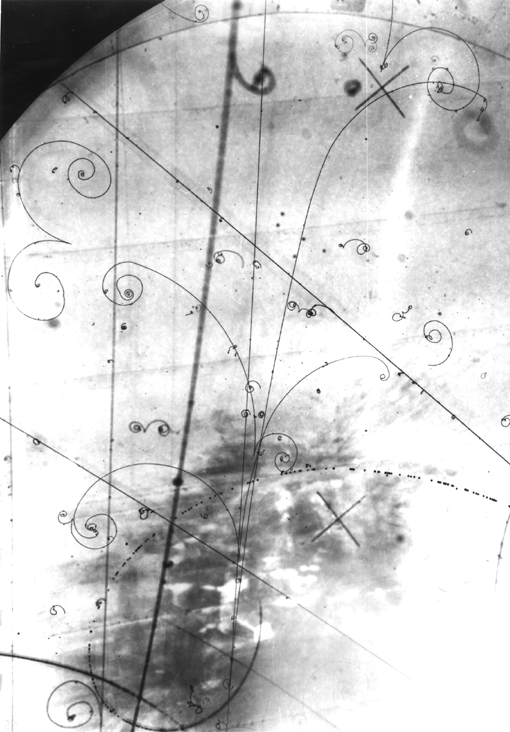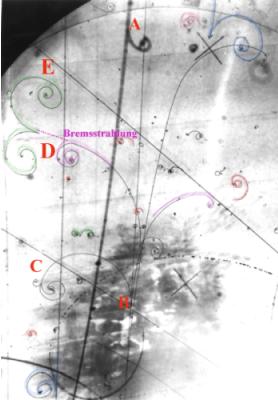

 |
|
Fig.1 This bubble chamber picture shows some electromagnetic events such as pair creation or materialization of high energy photon into an electron-positron pair (green tracks), the Compton effect (red tracks), the emission of electromagnetic radiation by accelerating charges (violet tracks) (bremsstrahlung) and the knock-on electrons or delta ray (blue tracks)
Can you find how many events of each interaction are present in this picture?
A- A high energy cosmic ray comes into the picture from the top and gives a knock-on electron, just like the knock-on electron on the incoming track from the bottom of the picture.
B- The mini electromagnetic shower studied in this picture starts here. In modern detectors, these showers are measured in electromagnetic calorimeters.
C-The positron in this picture loses energy abruptly, emitting a photon tangentially. This is SYNCHROTRON RADIATION. This photon then knocks an electron out of an atom - the Compton effect.
D- A photon has been emitted by an accelerating electron. (All electromagnetic radiation comes from accelerating charges.)
E-This
positive partner looks like an electron, but curls in opposite direction. This
is a positron. The positron-electron pair has been produced from a high energy
![]() ray in the field of a nucleus.
ray in the field of a nucleus.
|
|
Bremsstrahlung Effect At several points, a low momentum negative track can be seen, beginning on a track of much higher momentum. This is produced by electrons that track spiral in, due of energy lost when they pass the nuclei electric field. All accelerated charges radiate electromagnetic waves. In this case, the electron acceleration is provided by the coulombian field of nuclei of the medium through which the particle is moving. |
|
|
Electron-positron pair production At several points, two spiraling tracks, one positive
and one negative, are seen to emerge with a zero opening angle. These are
high energy photons materializing into electron-positron (
From the curvature of the
|
|
|
The Compton Effect At several points in the bubble chamber picture,
a lone spiraling electron can be seen. This is an electron that can be
knocked out of an atom by a high-energy photon
|
|
|
Knock-on Electrons or Delta Rays A curly line can be seen starting on the track of higher momentum. This is produced by electrons that have been knocked forward by the main track This trace tells us the direction of the magnetic field, which in this case is out of the paper.
|